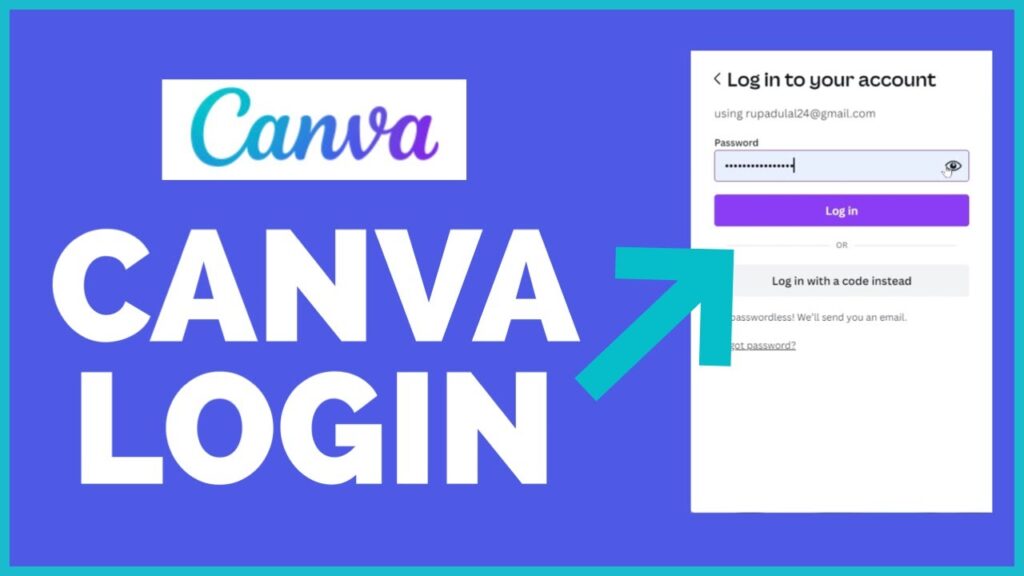Canvas Login: Canva is a user-friendly graphic design tool that offers a suite of features including templates, images, and fonts to enhance your creative projects.
Accessing your Canva account is crucial for maximizing productivity and unleashing your creativity, allowing you to efficiently design, collaborate, and share your work.
Understanding Canvas
Canvas is a comprehensive Learning Management System (LMS) designed to facilitate educational institutions in managing digital learning. It provides educators and students with an intuitive platform for online teaching and learning, streamlining the process with tools that support a wide range of educational activities.
Key Features and Benefits of Using Canvas
- Intuitive User Interface: Canvas boasts a clean, user-friendly interface that simplifies navigation and accessibility, making it easy for both instructors and students to find what they need quickly.
- Integrated Learning Tools: With features like grade books, course content modules, and a robust assignment management system, Canvas integrates all necessary tools in one platform, enhancing the learning experience.
- Mobile Compatibility: Canvas offers a mobile app available on both iOS and Android, allowing users to access course materials, submit assignments, and interact with their courses on the go.
- Customizable Features: Instructors can tailor the learning environment with customizable modules, which enables them to design their course layout in a way that best fits their teaching style and students’ learning needs.
- Collaboration Tools: Features such as integrated video conferencing, discussion forums, and group project tools facilitate effective student collaboration and communication.
- Scalability: Canvas can effortlessly scale to accommodate different sizes of educational institutions—from small schools to large universities—ensuring a consistent learning experience for all students.
- Comprehensive Analytics: The platform provides detailed analytics that help educators track student progress, assess the effectiveness of teaching materials, and make informed decisions to improve course delivery.
- Third-party Integrations: Canvas supports integrations with numerous third-party applications, enhancing its functionality and allowing institutions to extend its capabilities according to their specific needs.
- Reliable Support and Community: Canvas is backed by a strong support network that includes 24/7 technical support, a comprehensive knowledge base, and an active community of users who share tips and best practices.
By leveraging these features, Canvas not only enhances the educational experience but also prepares institutions for the future of digital learning.
Preparing for Your Canvas Login
Getting ready to access Canvas? Here’s a streamlined guide to ensure you have everything in place for a successful login and how to create a new account if you’re just starting.
Essential Prerequisites for a Canvas Login
- Device Compatibility: Ensure your device is compatible with the Canvas platform. Canvas works seamlessly on desktops, laptops, and mobile devices with updated web browsers.
- Internet Connectivity: A stable and reliable internet connection is crucial to access Canvas without interruptions.
- Updated Web Browser: Use the latest version of Google Chrome, Firefox, Safari, or Edge for the best experience on Canvas.
- Institution Email Address: You will need an active email address provided by your educational institution to log in or to authenticate your account.
- Course Enrollment Details: Have your course registration details handy, as you might need them to access specific courses once logged in.
How to Create a New Canvas Account
If you don’t already have a Canvas account, follow these steps to create one:
- Visit the Canvas Website: Go to the official Canvas webpage provided by your institution. Typically, the URL will be in the format of [schoolname].instructure.com.
- Sign Up for an Account: Click on the “Need a Canvas Account?” link usually found on the login page.
- Choose Account Type: Select the appropriate account type, such as “Student” or “Teacher,” based on your role.
- Provide Personal Information: Fill in the necessary details such as your name, email address, and any required educational or course-related information.
- Verify Your Email: After submitting your details, check your email for a verification link from Canvas. Click on this link to activate your account.
- Set Up Password: Choose a strong, secure password as part of the setup process.
- Log In: Return to the Canvas login page and enter your new credentials to start exploring your Canvas dashboard.
By following these steps, you can ensure a smooth start to your educational journey on Canvas, keeping all necessary tools and information at your fingertips.
Step-by-Step Guide to Canvas Login
Navigating the login process at Canva.com is straightforward, whether you are using the web platform or the mobile app. Here’s a simple guide to help you access your account seamlessly.
For Web Users
1. Visit the Website: Open your preferred browser and go to www.canva.com.

2. Access Login Page: Click on the “Log in” button located at the top right corner of the homepage.
3. Enter Your Details: Type your email address and password in the respective fields. If you’ve linked your Google or Facebook account, you can also use these options for a quicker login.
4. Complete the Login: Click on the “Log in” button to access your account. If you encounter any issues, use the “Forgot password?” link to reset your password.
For App Users
1. Download the App: Install the Canva app from the Google Play Store or Apple App Store.
2. Open the App: Tap on the Canva icon on your device to open the app.
3. Enter Login Credentials: Tap on the “Log in” section and enter your email and password. Alternatively, you can log in with your Google or Facebook account.
4. Access Your Account: After entering your credentials, tap “Log in” to start using Canva on your mobile device.
Importance of Reviewing Terms Before Agreeing
It’s crucial to review the terms and conditions before agreeing to them on any platform, including Canva. Here’s why:
- Understanding Rights and Responsibilities: The terms outline what Canva expects from you and what you can expect from Canva, including usage rights, subscription fees, and cancellation policies.
- Privacy Protections: You’ll learn how your personal information is collected, used, and protected. Understanding these policies helps you make informed decisions about sharing your data.
- Legal Implications: Agreeing to the terms without reviewing them could commit you to conditions you are not aware of, which might have legal implications.
- Updates and Changes: Terms and conditions can change. Knowing what you have agreed to helps you stay informed about your rights under the new conditions.
By following these steps and understanding the importance of terms and conditions, you ensure a smooth and informed experience on Canva.
Tips for Managing Your Canvas Account
Managing your Canvas account effectively can enhance your learning experience and ensure your data remains secure. Here are some essential tips on how to keep your account up-to-date and secure:
How to Recover or Reset Your Canvas Password
If you’ve forgotten your Canvas password or simply wish to reset it, follow these steps:
- Visit the Login Page: Go to your institution’s Canvas login page.
- Select ‘Forgot Password’: Click on the ‘Forgot Password’ link usually found below the login fields.
- Enter Your Email: Provide the email address associated with your Canvas account.
- Check Your Email: Open the email from Canvas and click on the reset link provided.
- Set a New Password: Choose a new, strong password that you haven’t used before on Canvas.
Setting Up Two-Factor Authentication for Enhanced Security
Adding two-factor authentication (2FA) to your Canvas account adds an extra layer of security. To set it up:
- Access Settings: Log into your Canvas account and navigate to ‘Settings’.
- Enable 2FA: Look for the option to ‘Enable Two-Factor Authentication’ and follow the prompts.
- Verify Your Device: Use your mobile device to verify the setup either through a text message or an authentication app.
- Complete Setup: Complete the process and ensure that 2FA is active whenever you log in.
Customizing Your Canvas Profile and Settings
Personalizing your Canvas profile can make your learning experience more engaging. Here’s how to customize your profile and settings:
- Edit Your Profile: Go to ‘Settings’ and click on ‘Edit Profile’ to add a profile picture, bio, and links.
- Adjust Notification Preferences: Tailor how and when you receive notifications from Canvas about courses, assignments, and announcements.
- Organize Dashboard: Customize your dashboard by organizing courses and groups to prioritize what’s most important to you.
By following these tips, you can manage your Canvas account more effectively, ensuring a smoother and more secure user experience.
Maximizing Your Use of Canvas
Canvas, a comprehensive learning management system, is pivotal for both instructors and students aiming to enhance their educational experiences. Here’s how you can maximize your use of Canvas to streamline project organization and collaboration.
Top Features in Canvas You Should Be Using
- Modules: Organize course content by week, topic, or project for streamlined access and structured learning.
- SpeedGrader: Facilitate quick and effective feedback on assignments and assessments, significantly reducing grading time.
- Canvas Commons: Share and import educational resources like quizzes, modules, and full courses from other educators within the Canvas network.
- Integrated Media Recorder: Enhance engagement by easily creating and embedding audio and video feedback or instructions directly within course content.
- Group Management: Create student groups to foster collaboration for projects, discussions, and peer reviews.
Tips for Organizing Projects and Collaborating with Others on Canvas
- Structured Modules: Utilize modules to organize all project-related materials, including instructions, resources, and assignment submissions. This keeps everything accessible and in chronological order.
- Consistent Update Logs: Regularly update the course announcements to keep all participants informed of project updates or changes. Encourage students to subscribe to notification updates.
- Clear Rubrics and Guidelines: Define clear expectations by using rubrics and detailed instructions for each project. This transparency helps minimize confusion and streamline the grading process.
- Utilize Discussion Boards: Foster a collaborative environment by encouraging the use of discussion boards for brainstorming and peer feedback.
- Regular Feedback: Make use of the SpeedGrader and comment features to provide ongoing feedback, which is crucial for iterative projects and helps maintain student engagement and improvement.
By leveraging these features and strategies, users can significantly enhance their efficiency and effectiveness in using Canvas, leading to a more organized and collaborative educational environment.
Common Problems and Solutions
Experiencing issues with logging into Canvas can be frustrating, but many of these problems have straightforward solutions. Here’s a breakdown of common Canvas login issues and how to resolve them efficiently:
1. Forgotten Password
Problem: A frequent issue is forgetting your password.
Solution: Use the “Forgot Password?” link on the Canvas login page. Enter your email address, and follow the instructions to reset your password.
2. Incorrect Username
Problem: Entering an incorrect username is another common error.
Solution: Double-check your username, ensuring no typos. If unsure, try using your email address or contact your institution to confirm your login credentials.
3. Browser Issues
Problem: Sometimes, outdated browsers or cache issues can hinder Canvas access.
Solution: Update your browser to the latest version, clear the cache and cookies, or try accessing Canvas with a different browser.
4. Connectivity Issues
Problem: Poor internet connection can lead to login failures.
Solution: Check your internet connection and try reconnecting your device to the network. If possible, try a wired connection or switch to a more stable Wi-Fi network.
5. Account Disabled
Problem: If login attempts fail multiple times, your account might be temporarily disabled.
Solution: Wait for a few minutes before trying again or contact your educational institution for help with reactivating your account.
Contacting Canvas Support for Unresolved Issues
If you’ve tried all the above solutions and still can’t access your account, it might be time to contact Canvas support:
- Via Email: Most institutions provide a dedicated support email for Canvas-related issues. Check your school’s IT support page for this information.
- Help Desk: Some schools have a help desk for technical support. This may include in-person assistance, phone support, or an online chat system.
- Online Resources: Canvas offers extensive online guides and a community forum where you can search for solutions or ask questions.
However, always keep your institution’s contact details handy for quick access to support when you face persistent login problems.
FAQs about Canvas Login
1. How do I log into Canvas?
To log into Canvas, visit your institution’s Canvas webpage, often found at [institution].instructure.com. Enter your username and password provided by your institution. If you’re accessing Canvas for the first time, you may need to set up your account using the instructions provided in your welcome email.
2. What should I do if I forget my Canvas password?
If you forget your password, click the “Forgot Password?” link on the Canvas login page. Enter your email address or username to receive a password reset link. Follow the instructions in the email to reset your password and regain access to your account.
3. Can I access Canvas on my mobile device?
Yes, Canvas is fully accessible on mobile devices. You can download the Canvas Student app from the Google Play Store or Apple App Store. Once installed, log in using your usual credentials to access courses and materials.
4. Is there a way to stay logged into Canvas on my device?
Most browsers and the Canvas mobile app offer options to remember your login information, allowing you to stay logged in on your device. However, for security reasons, it’s recommended to log out after each session if you are using a shared or public device.
5. Who should I contact if I have trouble logging into Canvas?
If you encounter issues logging into Canvas, contact your institution’s IT helpdesk or support center. They can assist with login issues, account recovery, and other technical problems.
6. What are the system requirements for using Canvas?
Canvas supports most modern web browsers, including Chrome, Firefox, Safari, and Edge. Ensure your browser is up to date for the best experience. Additionally, JavaScript must be enabled in your browser settings.
Conclusion
In summary, accessing your Canvas account involves a few straightforward steps: navigating to the Canvas website, entering your login credentials, and addressing any authentication prompts. By following these steps meticulously, you can ensure a seamless entry into your account.
We encourage you to dive deep into the plethora of resources and tools that Canvas offers. Whether for academic purposes, project management, or collaborative endeavors, Canvas is designed to enhance your productivity and learning experience.
Explore its comprehensive features to fully leverage this robust educational platform in all your projects. Embrace the opportunity to streamline your tasks and expand your capabilities with Canvas.
References
For those seeking additional information or validation of the details provided about the Canvas Login process, the following resources are highly recommended:
- Canvas Learning Management System Guide – Explore the comprehensive guide provided by Canvas on their official website, which offers detailed instructions and troubleshooting tips for logging in. Canvas Official Guide.
- Educational Technology Journals – Access a variety of scholarly articles and papers on the use of Canvas and other learning management systems in education through journals like the Journal of Educational Technology. These journals often provide deeper insights into the effectiveness and technical aspects of Canvas. Journal of Educational Technology.
- Tech Tutorials Blog – Visit blogs that specialize in educational technology tutorials, which frequently feature step-by-step guides on managing Canvas accounts and optimizing its use for educational purposes. Tech Tutorials.
These resources will not only help in understanding the Canvas Login process better but will also offer broader insights into maximizing the effectiveness of this essential educational tool.

